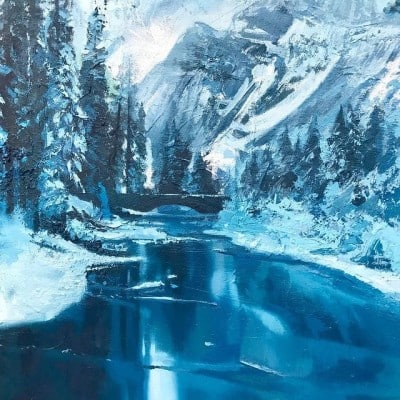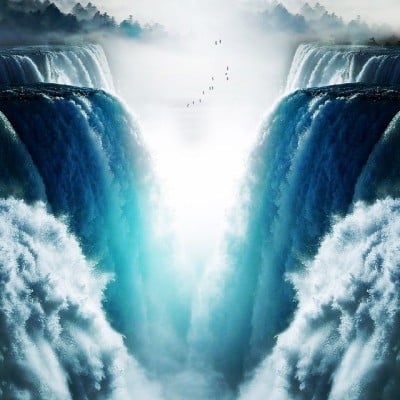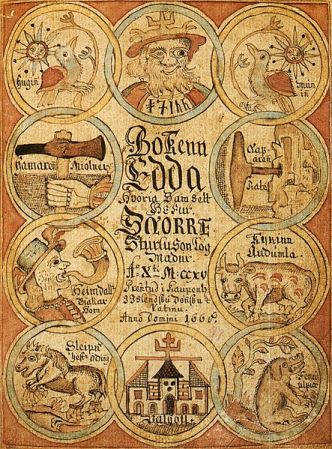Nestled within the vast expanse of Norse mythology, the Èlivágar stand as enigmatic rivers of creation, their origins as profound as the cosmos itself. These are not merely rivers in the conventional sense; they are the primordial waters from which giants emerged, a place veiled in the ancient narratives of creation. As we navigate the chilling currents of these mythical rivers, we unravel a saga woven into the very essence of the Norse universe, an elemental force within the grand design of Yggdrasil, the World Tree.
Èlivágar Key Facts
| Origins | Emanating from Hvergelmir |
| Old Norse | Èlivágar |
| Known for | Origin of Giants; Icy Rivers in Norse Mythology |
| Associated myths | Creation of Ymir; Boundaries of realms |
Name and Etymology
The name Èlivágar, is a compound of two elements: “Éli” and “vágar.” The prefix “Éli” is related to the Old Norse word élligr for “stormy”. The ending “vágar”, is the plural form of “vágr,” meaning “waves.” Thus, Èlivágar can be interpreted as “Stormy Waves” a name that is befitting of the tumultuous waters flowing out of the Hvergelmir (Roaring cauldron) well.
With regards to this translation, I realize I am possibly missing something as several other sites have the name meaning ‘Icy waves’. However, to the best of my ability I can’t see how the prefix ‘Éli’, is translated as ‘Icy’.
The Élivágar are flowing out of the ice realm of Niflheim, but the name itself doesn’t seem to be related to ice (Ida/Issa), cold or frozen. If I am wrong I would love a comment below!
Ancient or Primordial Rivers
There is another possible translation I find more interesting than the ‘Icy waves’ one, and that is ‘Ancient waves’, or ‘Primordial waves’. This is based on ‘Élli’, meaning ‘old age’ or in this case ancient/primordial. This is also the name of the woman Thor meets on his adventure at Utgarda-Loki. There he is made to wrestle with what he thinks is an old woman named Elli (Old Norse for old age). However, this is one of Utgarda-Loki’s tricks, and in reality she is the personification of old age.
Following this line of thought, Élivágar would come to mean ‘Ancient waves’. Being the oldest rivers, flowing out from Niflheim into the Ginnungagap that would be fitting as well.
The Eleven Rivers of Èlivágar

The Èlivágar are a collection of eleven rivers, each bearing a name rich in meaning:
Svöl (“Cool” or “Chill”): Reflecting the icy coldness of its waters.
Gunnþrá (“Battle-Thirsty”): Perhaps indicative of the violent and relentless flow, akin to the fervor of battle.
Fjörm (“Abundant”): Suggesting the great volume or force of the river.
Fimbulþul (“Mighty Noise”): Implies the roaring sound of the river, echoing the vastness of its presence.
Slíðr (“Dangerous”): A name that hints at the perilous nature of its currents.
Hríð (“Storm” or “Tempest”): Evoking the turbulent and stormy conditions associated with the river.
Sylgr (“Swallower”): Perhaps alluding to the river’s capacity to engulf or consume anything in its path.
Ylgr (“She-Wolf” or “Furious”): A name that could symbolize the river’s ferocity.
Víð (“Wide” or “Expansive”): Indicating the broad expanse of the river’s reach.
Leiptr (“Lightning”): Suggesting a swift and possibly treacherous flow, akin to a flash of lightning.
Gjöll (“Loud” or “Resounding”): Reflecting the echoing clamor of the river, which is also the name of the river closest to the gates of Hel.
Each name provides a glimpse into the character and perceived nature of these rivers within the Norse mythological landscape, painting a picture of a dynamic and formidable network of waters that were as much a part of the mythic narrative as the gods and giants themselves.
Origins of the Èlivágar
The tale of the Èlivágar harks back to the era before the cosmos took shape, to the times when the great void, Ginnungagap, lay between the realms of fire and ice. From Hvergelmir, the well of poisonous waters, the Èlivágar flowed, freezing and expanding into the void.
It was on the icy plains of this hostile expanse that life first stirred, with the emergence of Ymir, or Aurgelmir. He was the progenitor of the jötnar, and would soon be joined by Búri, first of the Aesir. Both, coming out of the ice, or pool of icy waters, created by the rivers flowing into Ginnungagap.

Later, much later really, the great stag Eikthyrnir would stand on top of Valhalla and eat leaves from Yggdrasil. Drops of dew would form from his antlers, and they would be dripping into and refilling Hvergelmir, next flowing over into the Élivágar. However, what filled the well, and the rivers, in those early days, before Yggdrasil had grown into the cosmic tree, or indeed before there even was a great hall called Valhalla, that is unknown. At least to me.
Mentions of Élivágar in Ancient Texts
The Élivágar hold a significant but understated presence in Norse mythology, mentioned within the foundational texts that scholars rely on to understand the ancient Norse worldview. These primordial rivers, sourced from the well of Hvergelmir, are depicted as the origins of the cosmos’s chaotic beginnings. The ancient texts, both the Prose and Poetic Eddas, reference the Élivágar not only as physical manifestations but also as metaphysical representations of the Norse universe’s inception.
In the Prose Edda, composed by Snorri Sturluson, and the collective poems of the Poetic Edda, the Élivágar are cited with a sense of reverence and importance. These sources provide a window into the old Norse understanding of the world, portraying the Élivágar as crucial elements in the narrative of creation and the emergence of life, including the first giants. The rivers’ icy flows are thus integral to the mythological landscape, shaping the early narratives of Norse myth.
Prose Edda
The Prose Edda, composed by Snorri Sturluson in the 13th century, is a primary source for modern understanding of Norse mythology. It provides a comprehensive narrative of the gods, their origins, and their eventual doom.

Gylfaginning
In “Gylfaginning,” the Élivágar are depicted as rivers that existed at the dawn of the cosmos. Sturluson describes the chilling waters that emanate from Hvergelmir and their significant role in shaping the early universe.
Chapter 5.
Said Ganglere: What took place before the races came into existence, and men increased and multiplied? Replied Har, explaining that as soon as the streams, that are called the Elivogs, had come so far from their source that the venomous yeast which flowed with them hardened, as does dross that runs from the fire, then it turned into ice. And when this ice stopped and flowed no more, then gathered over it the drizzling rain that arose from the venom and froze into rime, and one layer of ice was laid upon the other clear into Ginungagap.
Later in Gylfaginning Snorri also quotes a part that is obviously borrowed from the Poetic Edda poem Vafthrudnirsmál.
Poetic Edda
The Poetic Edda is a collection of Old Norse poems from various sources, providing a rich tapestry of myth and legend. The Élivágar are mentioned in several poems, highlighting their mythological importance.
Grímnismál
In “Grímnismál,” the Élivágar are mentioned in the context of the creation of the world. The verses speak of the rivers flowing from Hvergelmir and the life that arose from them.
Stanza 26.
The stag Eikthyrnir | stands by Odin’s hall,
Feeding on the branches of Læradr;
From his horns | drips into Hvergelmir
Flowing into all rivers.
Here the rivers aren’t actually called the Élivágar, but the next two stanzas go on to name all rivers, thirty-seven in all, not just the elven Élivágar.
Stanza 27.
Sid and Vid, | Sækin and Eikin,
Svol and Gunnthro,
Fiorm and Fimbulthul,
Rin and Rennandi,
Gipul and Gopul,
Gomul and Geirvimul,
They flow through the realms of gods;,
Thyn and Vin, | Tholl, and Holl,
Grad and Gunnthorin.
Stanza 28.
Vin is one named, | Vegsvin another,
A third is Thiodnuma,
Nyt and Not, | Nonn and Hronn,
Slid and Hrid, | Sylg and Ylg,
Vid and Van, | Vond and Strond,
Gjoll and Leipt, | they flow close to men,
And fall down to Hel after.
Hymiskviða
“Hymiskviða” recounts the tale of the gods’ quest to obtain a massive cauldron. The Élivágar are referenced as a boundary or landmark within the giants’ realm.
Stanza 5.
“There lives to the east of Elivagar,
Hymir the wise at the end of heaven;
My father has a fierce kettle,
A mighty vessel a mile deep.”
Vafþrúðnismál
“Vafþrúðnismál” is a wisdom poem where Odin and the giant Vafþrúðnir engage in a deadly game of knowledge. The Élivágar are mentioned as part of the ancient wisdom discussed between them.
Stanza 31.
Vafthruthnir spoke:
“Down from Élivágar | did venom drop,
And out of it formed till a giant it was;
And thence arose | our giants’ race,
Thus fierce are we seen.”
Frequently Asked Questions
The Èlivágar are the primordial rivers from which the giant Ymir emerged, playing a pivotal role in the Norse creation narrative and symbolizing the chaotic forces present at the dawn of time.
Ymir, the first of the giants, and the cow Audhumla, from whom the Aesir gods would eventually arise, both have their origins in the icy waters of the Èlivágar.
The Èlivágar rivers flow from Hvergelmir, the well of poisonous waters, which is also a source of life and sustenance for Yggdrasil, the World Tree.
Featured Image Credit: mr_writes_and_mrs_reads on Instagram
